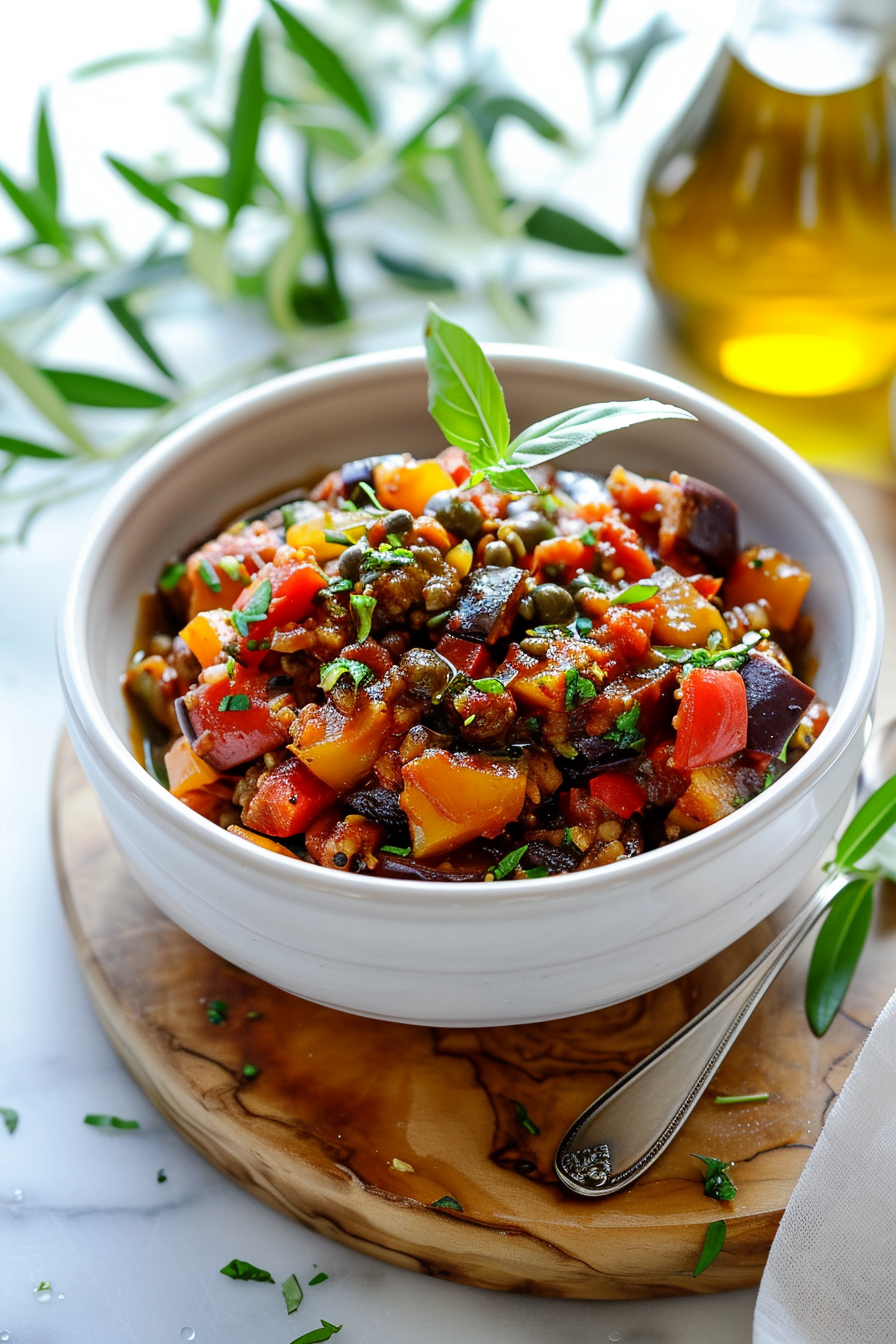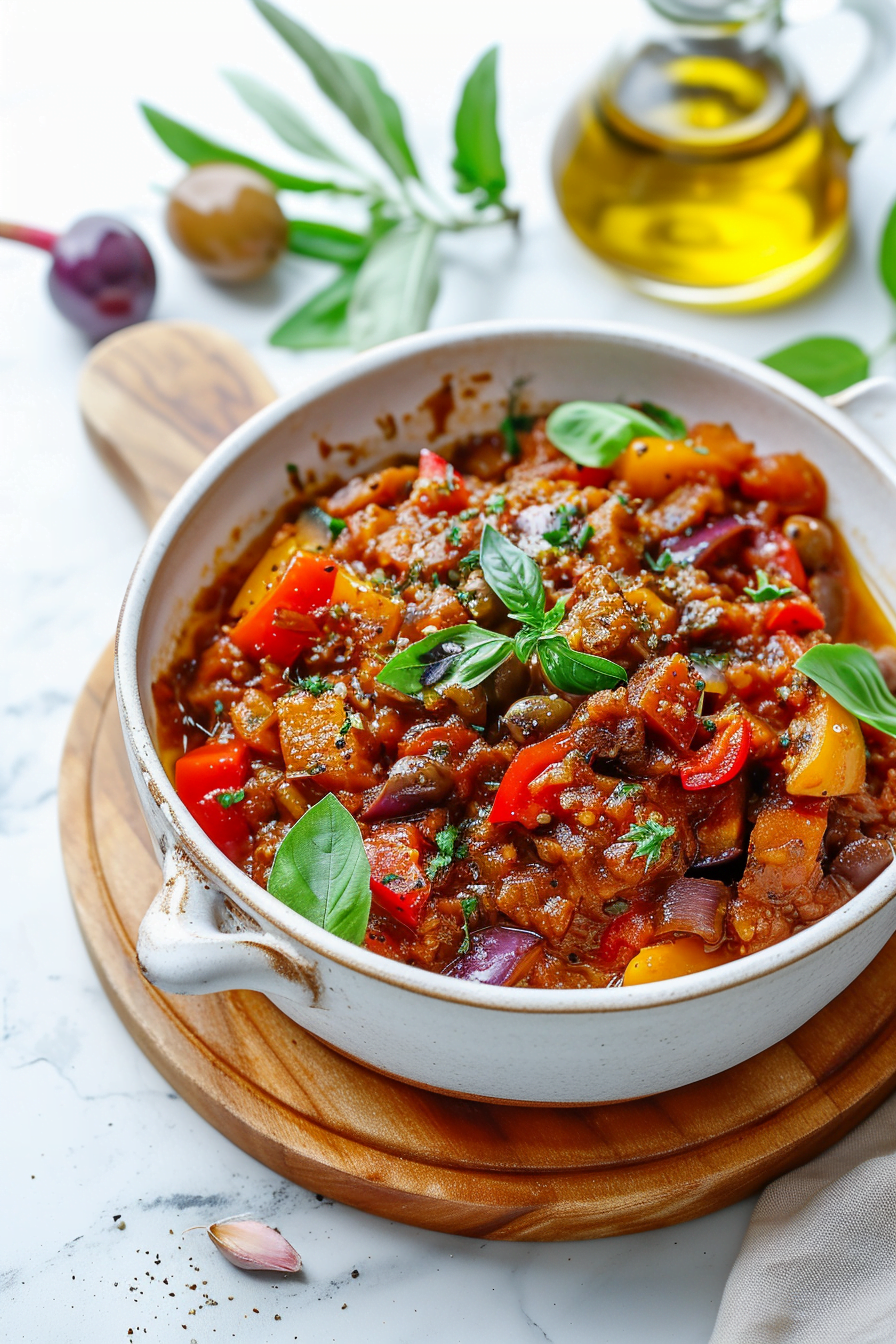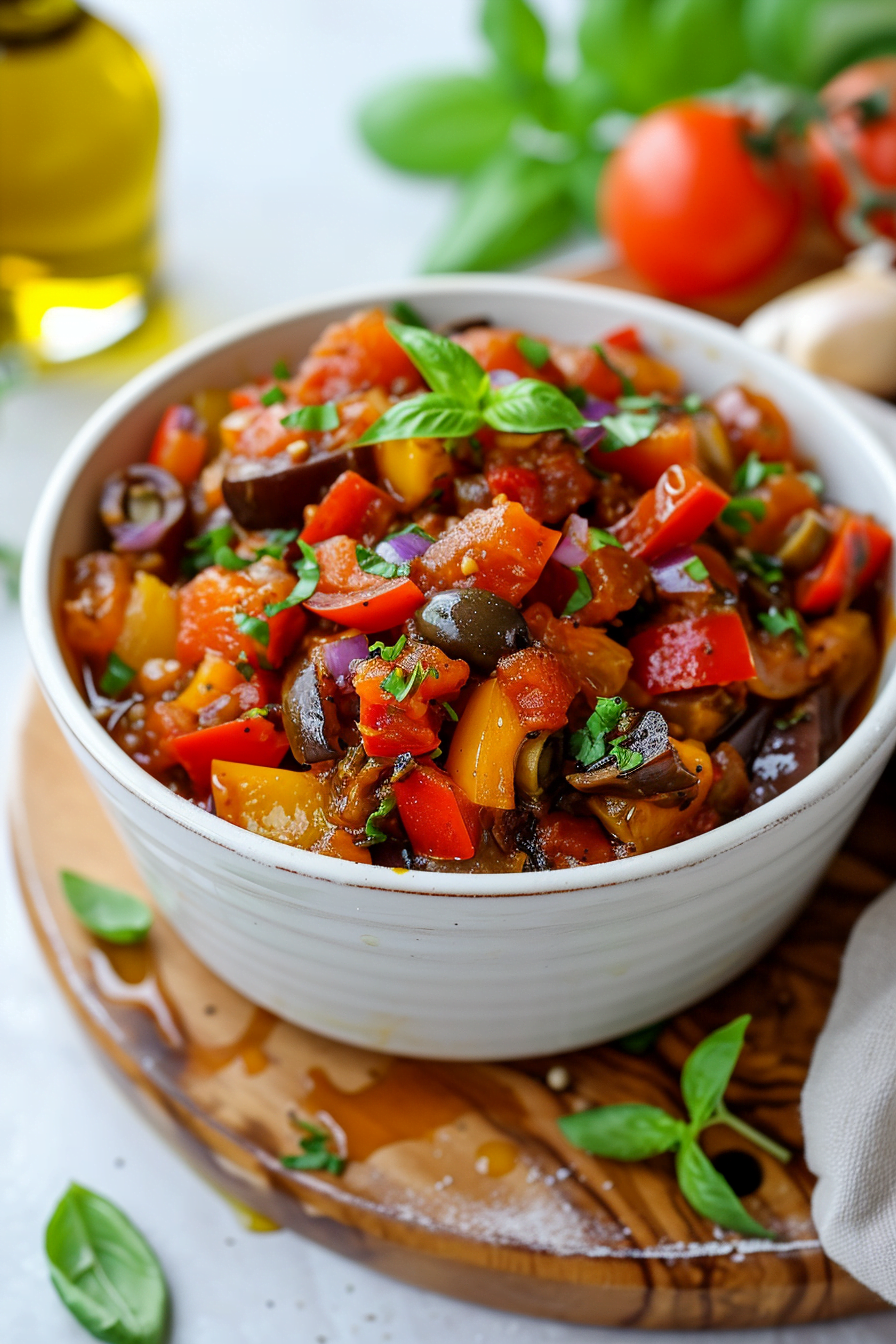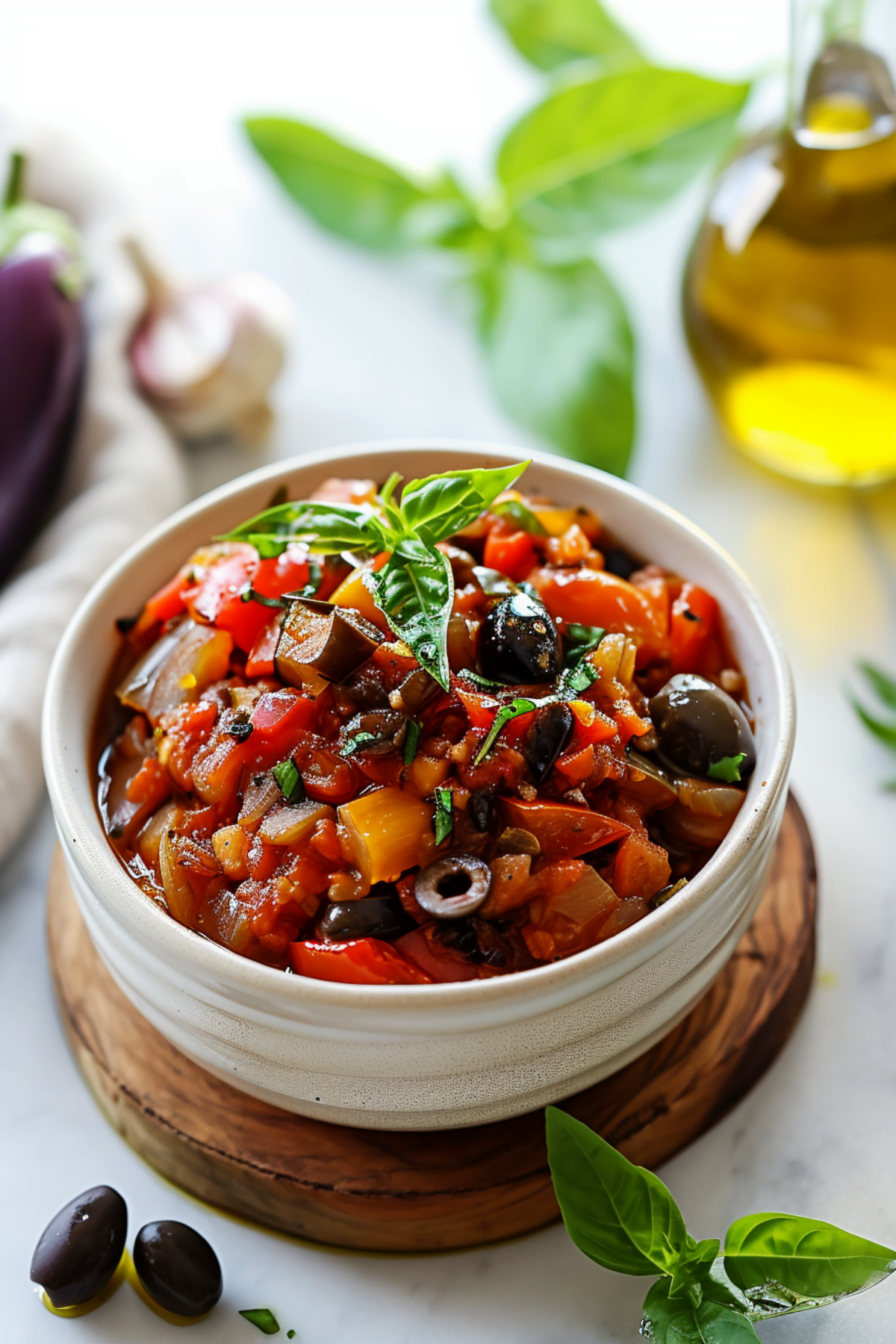Piedmontese Eggplant and Pepper Caponata: A Taste of Italy
Welcome to a delightful journey through the flavors of Piedmont with our Piedmontese Eggplant and Pepper Caponata. This dish is a vibrant celebration of the region’s rich culinary heritage, offering a perfect blend of sweet, tangy, and savory notes. Whether you’re a fan of Italian cuisine or looking to expand your palate, this caponata is sure to impress.
Imagine the robustness of eggplant paired with the sweetness of bell peppers, all tied together with a tangy tomato base and a sprinkle of Mediterranean herbs. This recipe is not just a treat for your taste buds but also a nutritious choice that aligns with the wholesome Mediterranean diet.
Read on to discover how to bring this Italian appetizer to your table, perfect for any occasion. Let’s embark on this culinary adventure together, and create a dish that’s as nourishing as it is delicious.

Unveiling the Piedmontese Eggplant and Pepper Caponata
The Piedmont region, nestled at the foot of the Alps in northwest Italy, is renowned not only for its exquisite wines and truffles but also for its rich vegetable dishes. The Piedmontese Eggplant and Pepper Caponata is a testament to the region’s love affair with fresh produce and robust flavors.
This caponata finds its roots in the traditional Sicilian caponata, a dish that typically features eggplant as the star. However, the Piedmontese twist incorporates the sweetness of local bell peppers and the depth of flavor from the region’s famed tomatoes. The addition of capers and Kalamata olives introduces a briny contrast that is characteristic of Mediterranean cuisine.
Each ingredient in the caponata plays a vital role, with the eggplant providing a meaty texture, the peppers adding a pop of color and sweetness, and the tomatoes creating a rich base. The capers and olives, along with a splash of red wine vinegar, offer a tangy punch that elevates the dish to new heights. The final touch of fresh basil infuses the caponata with an aromatic freshness that ties all the flavors together.
The beauty of this recipe lies in its simplicity and the symphony of flavors that emerge from such humble ingredients. This caponata is not just a dish; it’s a celebration of Piedmont’s agricultural bounty and a reflection of the region’s culinary philosophy – to let the natural flavors of the ingredients shine.

Mastering the Method
Starting with the Eggplant: Begin by sautéing the cubed eggplant in a generous amount of extra virgin olive oil. This initial browning is crucial as it develops a depth of flavor and ensures the eggplant has a pleasing texture. Be patient and allow the eggplant to become tender and golden brown. If it starts to stick, add a little water to the pan to deglaze and prevent burning.
Building the Base: Once the eggplant is set aside, use the same skillet to cook the red onion and garlic until they’re soft and fragrant. This step is essential for creating a flavorful foundation for your caponata. As the bell peppers join the mix, their natural sugars will caramelize slightly, adding a subtle sweetness.
Combining the Ingredients: When reintroducing the eggplant to the skillet along with tomatoes, capers, and olives, it’s important to season the mixture well with salt, pepper, and a hint of sugar to balance the acidity. The red wine vinegar is not just a seasoning but a key ingredient that brightens the entire dish, so don’t be shy with it. Allow the caponata to simmer gently, encouraging the flavors to meld harmoniously.
Finishing with Freshness: The torn basil leaves are not merely a garnish but an integral component that brings a burst of freshness to the caponata. Stir them through just before serving to preserve their vibrant color and aroma.
Remember, the key to a great caponata is patience and allowing each ingredient to contribute its best qualities to the dish. Take your time, taste as you go, and enjoy the process of creating this Piedmontese masterpiece.

Variation: Caponata with a Crunch
For those who prefer a bit more texture in their caponata, consider reducing the cooking time of the vegetables. This will retain a firmer bite, especially in the eggplant and peppers, giving the dish a delightful crunch. Additionally, you could add toasted pine nuts or almonds in the final few minutes of cooking for an extra layer of crunch and nuttiness.
Variation: Protein-Packed Caponata
If you’re looking to turn this appetizer into a heartier meal, try adding some diced, cooked chicken or a handful of chickpeas. The protein will complement the vegetables and make for a more satisfying dish. Be sure to add the protein with the tomatoes so it can absorb the flavors of the caponata.
Variation: Seafood Caponata
Incorporating seafood into your caponata can transform it into a coastal Italian delight. A few minutes before the caponata is finished cooking, add some seared shrimp or chunks of firm white fish. The seafood will cook quickly and infuse the caponata with a delicate, briny flavor reminiscent of the Mediterranean Sea.
Substitutions for Your Caponata
Eggplant Alternatives: If eggplant is not your vegetable of choice or simply not available, zucchini makes an excellent substitute. It has a similar texture and absorbs flavors well, making it a versatile option for this dish. Cut the zucchini into half-moons and follow the same steps as you would with the eggplant.
Pepper Varieties: While red and yellow bell peppers are traditional, feel free to experiment with different types of peppers. Try using roasted sweet peppers for an added depth of flavor, or add a small amount of spicy pepper, like a jalapeño, to introduce a little heat to the dish.
Tomato Alternatives: Fresh tomatoes are ideal, but when they’re out of season, a good quality canned tomato can work just as well. Choose whole, peeled tomatoes and crush them by hand for a rustic texture. Adjust the seasoning as canned tomatoes may have a different acidity level compared to fresh ones.
Frequently Asked Questions
Q: Can I make this caponata ahead of time?
A: Absolutely! The flavors of the caponata actually develop and improve when left to sit overnight in the refrigerator. Just be sure to bring it to room temperature before serving for the best taste.
Q: Is this dish suitable for vegans?
A: Yes, the Piedmontese Eggplant and Pepper Caponata is naturally vegan. It’s a wonderful dish that can be enjoyed by everyone, regardless of dietary preferences.
Q: How can I store leftovers?
A: Leftover caponata can be stored in an airtight container in the refrigerator for up to 5 days. It can also be frozen for up to 3 months, though the texture of the vegetables may change slightly upon thawing.
Q: What can I serve with this caponata?
A: This caponata is versatile and can be served as an appetizer with crusty bread, as a side dish with grilled meats or fish, or even tossed with pasta for a quick and flavorful meal.
Q: Can I use a different type of vinegar?
A: While red wine vinegar is traditional, you can use balsamic vinegar for a richer, slightly sweeter flavor. Apple cider vinegar is another alternative that can provide a similar tangy profile.

Piedmontese Eggplant and Pepper Caponata
Equipment
- Large skillet
- Cutting board
- Chef's knife
- Measuring cups and spoons
- Stirring spoon
Ingredients
- 1 large Eggplant (aubergine) approximately 1 lb or 450g, cubed
- 2 Bell peppers red and yellow, seeded and diced
- 1 medium Red onion about 5 oz or 150g, finely chopped
- 2 Garlic cloves minced
- 3 medium Tomatoes about 1 lb or 450g, peeled and chopped
- 2 tbsp Capers about 1 oz or 28g
- 1/3 cup Kalamata olives about 1.5 oz or 45g, pitted and halved
- 2 tbsp Red wine vinegar about 1 oz or 30ml
- 3 tbsp Extra virgin olive oil about 1.5 oz or 45ml
- 1 tsp Sugar about 0.2 oz or 4g
- Fresh basil leaves a small bunch, torn
- Salt and pepper to taste
Instructions
- Preheat a large skillet over medium heat and add 2 tablespoons of extra virgin olive oil.
- Add the cubed eggplant to the skillet and sauté until it starts to become tender and slightly browned, about 8-10 minutes. Remove the eggplant from the skillet and set aside.
- In the same skillet, add the remaining tablespoon of olive oil along with the chopped red onion and minced garlic. Cook until the onion is soft and translucent, approximately 5 minutes.
- Stir in the diced bell peppers and continue to cook for another 5 minutes, or until they are just beginning to soften.
- Return the eggplant to the skillet with the peppers and onions, and add the chopped tomatoes, capers, and olives. Mix well to combine.
- Season the mixture with salt, pepper, and sugar. Drizzle the red wine vinegar over the vegetables and give everything a good stir.
- Reduce the heat to low and let the caponata simmer for 20-25 minutes, or until the vegetables are very tender and the flavors have melded together.
- Check for seasoning and adjust if necessary. Just before serving, stir through the torn basil leaves for a fresh flavor.
Notes

